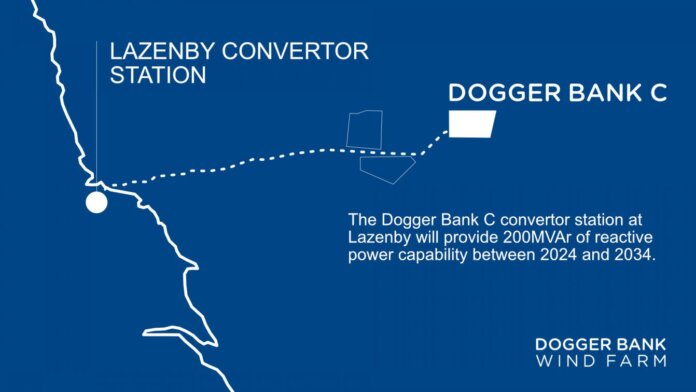Dogger Bank Wind Farm has secured a U.K. power first by becoming the first offshore wind farm project to win a tender from National Grid ESO to provide reactive power capability.
Under new £22.5 million Pennines Voltage Pathfinder contracts, National Grid ESO has awarded a 10-year power contract to Dogger Bank C that will see its onshore converter station at Lazenby in the northeast of England provide 200 MV Ar of reactive power capability between 2024 and 2034. This marks the first time that an offshore wind transmission asset has been awarded a contract through a reactive power tender by National Grid ESO.
Under its Pennines Voltage Pathfinder program, National Grid ESO identified the need for reactive power solutions to be provided in the years ahead in the northeast of England following the expected closure of Hartlepool nuclear power station in March 2024.
Following a competitive process, Dogger Bank C wind farm’s offshore transmission asset has been selected to provide the reactive power capability needed to help stabilize voltage on the grid for 10 years from 2024. SSE Renewables, which is leading on the construction of Dogger Bank Wind Farm, is due to commence onshore construction works for the offshore transmission asset later this summer.
“Dogger Bank Wind Farm is continually pushing the boundaries of what can be achieved through the delivery of an offshore wind farm, breaking records and setting new milestones here in the U.K. and globally,” says Steve Wilson, SSE Renewables’ project director for Dogger Bank Wind Farm.
Located off the northeast coast of England, Dogger Bank Wind Farm is being built in three 1.2 GW phases with an overall capacity of 3.6 GW. Dogger Bank C, which won a CfD in the 2019 auction, is around 560 km² in size and at its closest point is 196 km from shore. The third phase of the project is being developed on a different timescale to the first two phases, Dogger Bank A and B, which are being constructed at the same time. Dogger Bank C will connect to the national grid at the existing Lackenby Substation in Teesside.
“These services take us another step closer to 100 percent zero carbon operation, showcasing Britain’s innovation in engineering and driving competition within the system, ultimately saving consumers millions of pounds,” comments Julian Leslie, head of networks at National Grid ESO. “Reactive power capability is vital for managing voltage and being able to operate a zero-carbon system of the future so we’re excited to see that an offshore wind farm’s transmission asset will deliver reactive power to support the wider network for the first time in Britain.”
Dogger Bank Wind Farm is located more than 130 km off the coast of England and is being delivered by joint venture partners SSE Renewables, Equinor and Eni. SSE Renewables is leading on construction and delivery while Equinor will operate the wind farm on completion. Due to its size and scale, Dogger Bank is being built in three consecutive 1.2GW phases; Dogger Bank A, Dogger Bank B and Dogger Bank C. In total the wind farm is expected to generate enough renewable electricity to supply 5% of the U.K.’s demand, equivalent to powering six million homes.





Reactive power needs to be generated close to the reactive loads, as reactive power does not travel far on the grid. So how can a reactive power generator in the remote North Sea, Dogger Bank be effective?